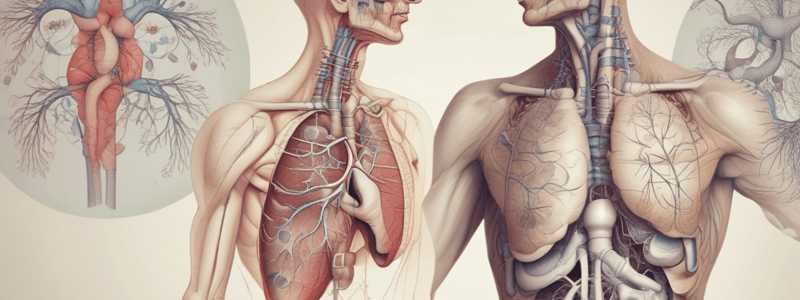Podcast
Questions and Answers
What type of epithelial lining is present in larger bronchioles?
What type of epithelial lining is present in larger bronchioles?
What type of cells are found in bronchioles and are believed to protect the bronchiolar epithelium?
What type of cells are found in bronchioles and are believed to protect the bronchiolar epithelium?
What is a key difference in the muscle layers between bronchi and bronchioles?
What is a key difference in the muscle layers between bronchi and bronchioles?
What is true about the cartilage in bronchioles?
What is true about the cartilage in bronchioles?
Signup and view all the answers
What is the function of Clara cells in bronchioles?
What is the function of Clara cells in bronchioles?
Signup and view all the answers
What is the characteristic of the trachealis muscle in the trachea?
What is the characteristic of the trachealis muscle in the trachea?
Signup and view all the answers
What is the result of metaplasia in the respiratory epithelium?
What is the result of metaplasia in the respiratory epithelium?
Signup and view all the answers
What is the main difference between the walls of the trachea and the primary bronchi?
What is the main difference between the walls of the trachea and the primary bronchi?
Signup and view all the answers
What is the characteristic of the right bronchus compared to the left bronchus?
What is the characteristic of the right bronchus compared to the left bronchus?
Signup and view all the answers
What is the characteristic of the intrapulmonary bronchi?
What is the characteristic of the intrapulmonary bronchi?
Signup and view all the answers
What is the main function of the epithelium in the trachea?
What is the main function of the epithelium in the trachea?
Signup and view all the answers
Which type of cells are responsible for producing mucinogen in the trachea?
Which type of cells are responsible for producing mucinogen in the trachea?
Signup and view all the answers
What is the main difference between the epithelial lining of the trachea and that of the bronchioles?
What is the main difference between the epithelial lining of the trachea and that of the bronchioles?
Signup and view all the answers
What is the function of the elastic fibers in the trachea?
What is the function of the elastic fibers in the trachea?
Signup and view all the answers
What is the main function of the basal cells in the trachea?
What is the main function of the basal cells in the trachea?
Signup and view all the answers
Study Notes
Bronchioles
- Bronchioles are the 10th to 15th generation of dichotomous branching of the bronchial tree
- Less than 1 mm in diameter
- Supplies air to a pulmonary lobule
- Bronchioles possess no cartilage
- The epithelial lining of bronchioles ranges from ciliated simple columnar with occasional goblet cells in larger bronchioles to simple cuboidal (many with cilia) with occasional Clara cells and no goblet cells in smaller bronchioles
- The lamina propria of bronchioles has no glands; it is surrounded by a loose meshwork of helically oriented smooth muscle layers
Clara Cells
- Clara cells are believed to protect the bronchiolar epithelium by lining it with their secretory product
- Produce a surfactant-like material that reduces the surface tension of bronchioles and facilitates the maintenance of their patency
- Clara cells divide to regenerate the bronchiolar epithelium
Trachea
- The trachea is rounded anteriorly but flattened posteriorly
- 10 to 12 horse-shoe-shaped hyaline cartilage rings (C-rings) that are connected to each other by smooth muscle
- The perichondrium of each C-ring is connected to those of other rings
- Provides flexibility and permits elongation during inspiration
Respiratory Epithelium
- The respiratory epithelium undergoes reversible alterations (metaplasia) due to chronic exposure to irritants (e.g., cigarette smoke and coal dust)
- Increase in the number of goblet cells relative to ciliated cells, producing a thicker layer of mucus to remove irritants
- Reduced number of cilia retards the rate of mucus elimination, resulting in congestion
Bronchi
- Begins at the bifurcation of the trachea
- Composed of airways located outside and inside the lung
- Outside: 1° bronchi, extrapulmonary bronchi
- Inside: intrapulmonary bronchi, bronchioles, respiratory bronchioles
Cartilages
- Elastic cartilages (unpaired epiglottis, paired corniculate and cuneiform cartilages, and superior aspect of the arytenoids) connected to one another by ligaments
- Their movements are controlled by intrinsic and extrinsic skeletal muscles
Epiglottis
- Flexible flap of tissue, consisting of central elastic cartilage, covered by mucosa on both sides
- During swallowing, positioned horizontally, closing off the upper entrance to the larynx
- During respiration, stands straight up in the vertical position, permitting the flow of air
Studying That Suits You
Use AI to generate personalized quizzes and flashcards to suit your learning preferences.
Related Documents
Description
Learn about the structure and function of bronchioles, including their size, epithelial lining, and role in supplying air to pulmonary lobules.




